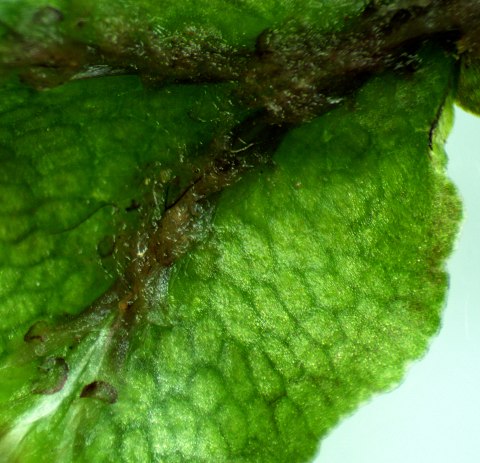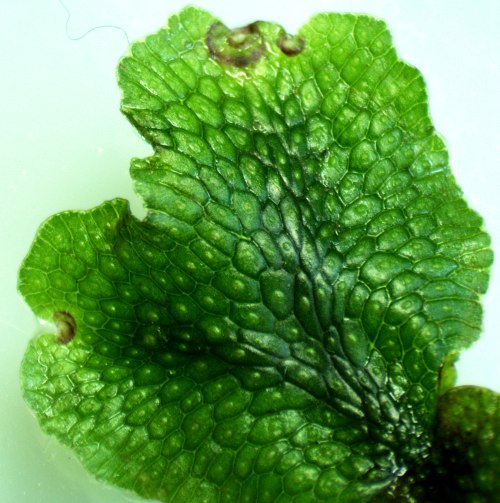
The margins of the thallus are somewhat undulate and narrowly translucent-membranous (hyaline); they are either flat or curve slightly downward. The growing tips of the thallus lobes are somewhat notched in the middle. The lower surface of the thallus is light green and more or less flat. Along the middle of the underside of each thallus lobe, there are peg-like scales (about 5 mm. long), smooth rhizoids (about 10 mm. long), and tuberculate rhizoids (about 15 mm. long). The smooth rhizoids extend into the ground and anchor the thallus. The tuberculate rhizoids extend horizontally along the middle lower surface of each thallus lobe; they transport moisture along the length of the thallus lobes. This liverwort is dioecious, forming male reproductive organs (antheridia) and female reproductive organs (archegonia) on separate plants. As a general rule, these reproductive organs are not produced every year. On male plants, the antheridia are embedded in a disk-like receptacle on the upper surface of the thallus near the notched growing tips of its lobes. This receptacle is sessile, but slightly higher than the surrounding surface. The receptacle is usually circular in shape, but sometimes it is oval or half-circular in shape; it is densely tuberculate on the upper surface. At maturity, after there has been some exposure to moisture, the antheridia release their sperm in jets of air (a form of mechanical ejection); see Shimamura et al. (2008).

Thus, the sperm are partially distributed by air currents. Upon contact with wet ground, the two-tailed sperm swim about; fertilization occurs when some of the sperm reach the archegonia of female plants (this usually occurs during the autumn). The archegonia of female plants are located initially on the upper surface of their thalli. The following spring after fertilization, the receptacle of the archegonia becomes elevated on a more or less erect stalk. This stalk is white-membranous, terete, and hairless. At the apex of each stalk, the brownish receptacle of the archegonia has a conical or domed-conical shape; it is slightly lobed along its margin where individual archegonia occur. At maturity, the archegonia on the underside of the receptacle resemble black capsules that are short-oblongoid in shape; they soon split open to release the elaters (coiled structures) and spores to the wind. In addition, the spores can be distributed by water currents if they land on bodies of water. Both the head-like receptacle and its stalk wither away shortly afterwards. Individual spores are relatively large in size (60-100 micrometers across), more or less globoid in shape, and densely tuberculate. On rare occasions, this liverwort forms tiny tubers that can result in the development of clonal plants at a later date.
Cultivation: This liverwort prefers dappled sunlight to medium shade, consistently moist or wet conditions (including occasional submergence in water), some protection from wind, and either rocky ground or rock surfaces with a thin layer of soil containing organic matter. It is able to tolerate dense shade to a greater extent than most plants.

Range & Habitat: Snakeskin Liverwort (Conocephalum salebrosum) occurs in scattered areas throughout Illinois, where it is native and occasional (see Distribution Map). This liverwort is widely distributed in North America, Europe, and east Asia. In Illinois, habitats include moist limestone and sandstone cliffs, seepage areas of sandstone outcrops, sandstone walls along streams, rocky places along streams and springs, rocks at the head of springs, shallow water of springs, rocky places and muddy ground at the base of waterfalls, clay banks along streams, peaty soil on limestone talus, rocks and clay slopes of wooded ravines, bottoms of wooded ravines, moist shaded rocks in canyons, wet ground at the base of trees, north-facing slopes of coal-spoils, and cement construction debris on moist wooded hillsides. In general, Snakeskin Liverwort is found on rocky material in damp shaded locations where there is some protection from wind. In Illinois, this liverwort is usually found in high quality natural areas, although it also occurs in disturbed areas.
Faunal Associations: Information about floral-faunal relationships for this liverwort is largely unavailable. Because of the large size of the spores, it is possible that animals play a minor role in their dispersal to new locations.
Photographic Location: Sandstone rock and sandstone embankment along a stream at Turkey Run State Park in west-central Indiana. This rocky substrate was mostly covered with a thin layer of soil, where various mosses and the Bulblet Fern (Cystopteris bulbifera) were also present.

Comments: Until recently, this liverwort was referred to as Conocephalum conicum, and this scientific name is still found in many published sources of information. However, Szweykowski et al. (2005) have presented evidence that specimens formerly regarded as Conocephalum conicum in Europe are actually two similar species, Conocephalum conicum and Conocephalum salebrosum, that can be distinguished both genetically and morphologically. As a result, all of the specimens formerly regarded as Conocephalum conicum in North America are currently considered examples of the more widely distributed Conocephalum salebrosum. Thus far, the redefined Conocephalum conicum has not been reported from North America. Snakeskin Liverwort (Conocephalum salebrosum) is also somewhat similar in appearance to a native liverwort in Illinois, Umbrella Liverwort (Marchantia polymorpha). Snakeskin Liverwort can be readily distinguished from the latter species by the following characteristics: 1) the reticulated indentations of its upper surface are less shallow and more conspicuous than those of the latter liverwort, 2) it lacks the gemmae cups that are so common on the upper surface of the latter liverwort, 3) its male reproductive structures are sessile, rather than stalked, and 4) its spores are much larger in size. Generally, Snakeskin Liverwort doesn't produce male and female reproductive structures nearly as often as Umbrella Liverwort, and it tends to occur in less disturbed habitats than the latter. The thallus of Snakeskin Liverwort, when it is pulverized, has been considered aromatic by many observers, but they differ greatly among each other in its description. It has been found that extracts of this liverwort have antibiotic action against several strains of pathogenic bacteria, thus it could have possible applications in medicine (Castaldo-Cobianchi et al., 1988). Other common names of Conocephalum salebrosum (also applied to Conocephalum conicum) are Snakewort, Cat-tongue Liverwort, Mushroom-headed Liverwort, and Great Scented Liverwort.